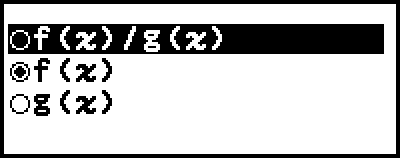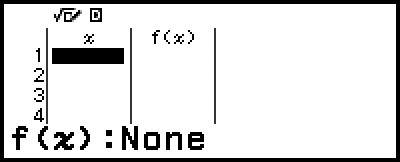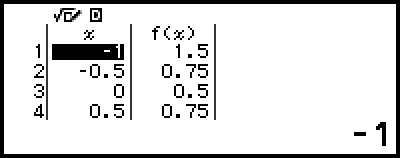Creating a Number Table
You can use the Table app to create a number table based on the defining equations registered for functions f(x) and g(x).
General Procedure for Creating a Number Table
Example : To generate a number table for the function f(x) = x2 + 12 for the range -1 ≤ x ≤ 1, incremented in steps of 0.5
1. Press  , select the Table app icon, and then press
, select the Table app icon, and then press  .
.
This displays the number table screen.
If a defining equation is not registered for either or both of f(x) and g(x) and the data at the cursor selection position is empty, a message will appear at the bottom of the screen indicating that the defining equation is not registered.
2. Configure settings to generate a number table from the function.
(1) Press  , and then select [Table Type] > [f(x)].
, and then select [Table Type] > [f(x)].
(2) Press  .
.
For information about settings, see "Maximum Number of Rows in a Number Table According to Table Type".
3. Register a defining equation for f(x).
 – [Define f(x)/g(x)] > [Define f(x)]
– [Define f(x)/g(x)] > [Define f(x)]


 1
1 2
2

- (Screen immediately before you pressed
 )
)
You can also use  to register a defining expression. For more information, see "Defining Equation Registration".
to register a defining expression. For more information, see "Defining Equation Registration".
4. Configure the number table range setting.
 – [Table Range]
– [Table Range]

 ((-))1
((-))1 1
1 0
0 5
5

5. Press  .
.
This displays the result in the number table screen.
The number table generation operation causes the contents of variable x to be changed.
Note
On the number table screen, you can store the value in a cell to a variable. For example, performing the following operation while the screen in step 6 is displayed above will store -1 to variable A:  – [A=] > [Store]. For details about variables, see "Variables (A, B, C, D, E, F, x, y, z)".
– [A=] > [Store]. For details about variables, see "Variables (A, B, C, D, E, F, x, y, z)".
Maximum Number of Rows in a Number Table According to Table Type
You can configure number table screen settings to show columns for both f(x) and g(x), or for either one of them. To set it, use the menu that appears when you press  – [Table Type] while the number table screen is displayed.
– [Table Type] while the number table screen is displayed.

f(x)/g(x) ... Show both f(x)- and g(x)-columns
f(x) ... Show only f(x)-column (initial default setting)
g(x) ... Show only g(x)-column
The maximum number of rows in the generated number table depends on the Table Type setting. Up to 45 rows are supported for the "f(x)" or "g(x)" setting, while 30 rows are supported for the "f(x)/g(x)" setting.
Defining Equation Registration
There are two ways to register defining equations for f(x) and g(x).
While the Table app number table screen is displayed, registering an equation by pressing 
 – [Define f(x)/g(x)] > [Define f(x)]
– [Define f(x)/g(x)] > [Define f(x)]
 – [Define f(x)/g(x)] > [Define g(x)]
– [Define f(x)/g(x)] > [Define g(x)]
While the Table app number table screen is displayed, or while using any calculator app except Ratio and Math Box, registering an equation by pressing 
 – [Define f(x)]
– [Define f(x)]
 – [Define g(x)]
– [Define g(x)]
The same f(x) or g(x) equation registration screen appears regardless of which of the two above operations is used to register defining equations.
Note
For details about operations using  , see "Registering and Using Defining Equations for f(x) and g(x)".
, see "Registering and Using Defining Equations for f(x) and g(x)".
Editing Number Table Screen Data
To delete a row
1. On the number table screen, move the cursor to the row you want to delete.
2. Press  .
.
To insert a row
1. On the number table screen, move the cursor to the row that will be under the row you will insert.
2. Perform the following operation:  – [Edit] > [Insert Row].
– [Edit] > [Insert Row].
To delete all number table screen contents
On the number table screen, perform the following operation:  – [Edit] > [Delete All].
– [Edit] > [Delete All].
To change the value input in a cell in column x
You can change the value in the currently highlighted x cell. Changing the x value causes the f(x) and g(x) values in the same row to be updated accordingly.
To enter a value into the highlighted x-column cell using: {value of the cell above} +/- {step value}
If there is value in the x cell above the currently highlighted x cell, pressing  or
or  automatically inputs into the highlighted cell the value equal to the value of the cell above it plus the step value. So also, pressing
automatically inputs into the highlighted cell the value equal to the value of the cell above it plus the step value. So also, pressing  automatically inputs the value equal to the value of the cell above less the step value. The f(x) and g(x) values in the same row are also updated accordingly.
automatically inputs the value equal to the value of the cell above less the step value. The f(x) and g(x) values in the same row are also updated accordingly.
f(x) and g(x) Update Timing
f(x) and g(x) values displayed on the number table screen are updated when any of the following occurs.
When  is pressed while [Execute] is selected on the Table Range screen.
is pressed while [Execute] is selected on the Table Range screen.
When the defining equations for f(x) and g(x) are updated (except when a defining equation is a composite function).
When a number is input into column x (including pressing  ,
,  ,
,  in column x).
in column x).
Note, however, that values are not updated automatically after the following operations.
When the SETTINGS menu is used to change the Angle Unit setting.
When the variable of a defining equation is updated (new numeric value stored) when a defining equation that contains a variable (example: f(x) = 2x + A) is registered.
When the defining equation of a composite function (Example: g(x) = f(x) × 2 - x) is registered, and the defining equation of the reference function (Example: f(x) of g(x) = f(x) × 2 - x) is updated (new defining equation registered).
In these cases, execute  – [Recalculate] while the number table screen is displayed to update values.
– [Recalculate] while the number table screen is displayed to update values.
Data Retention
Doing the following will discard some data and clear some settings of the Table app.
① Returning to the HOME screen and launching another calculator app.
② Pressing  .
.
③ Changing the Input/Output setting with the SETTINGS menu.
④ Changing the Table Type setting with the TOOLS menu.
The table below shows which data is discarded and which data is retained.
Operation Data, Setting |
① | ② | ③ | ④ |
| Number table data (x-, f(x)-, g(x)-columns) |
Discarded | Discarded | Discarded | Discarded |
| Table Range settings | Discarded | Retained | Retained | Retained |
| Table Type settings | Retained | Retained | Retained | -- |
| f(x), g(x) defining equations | Retained | Discarded | Discarded | Retained |


